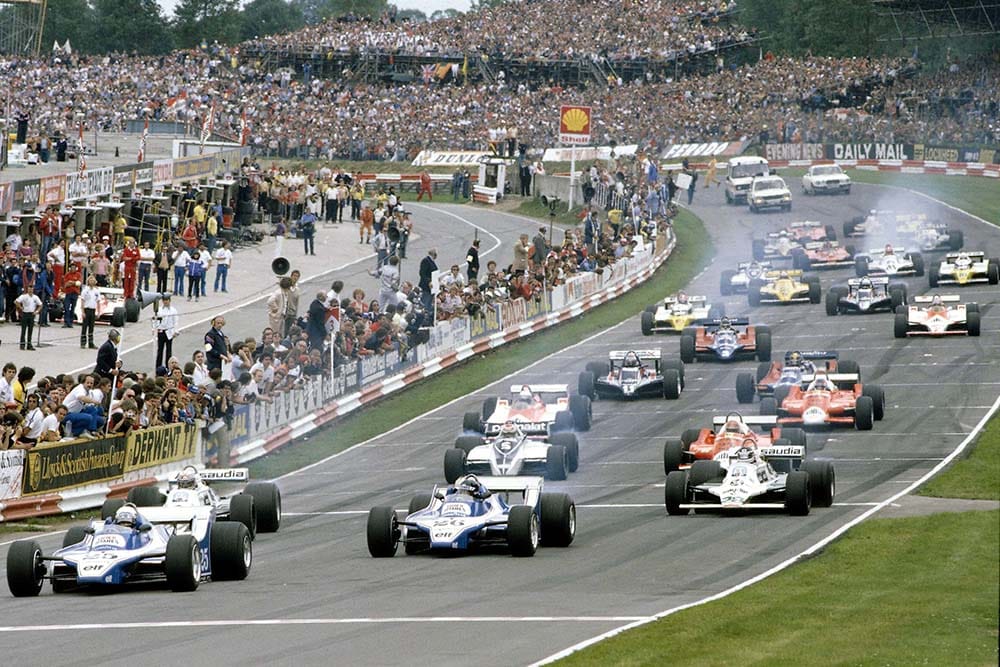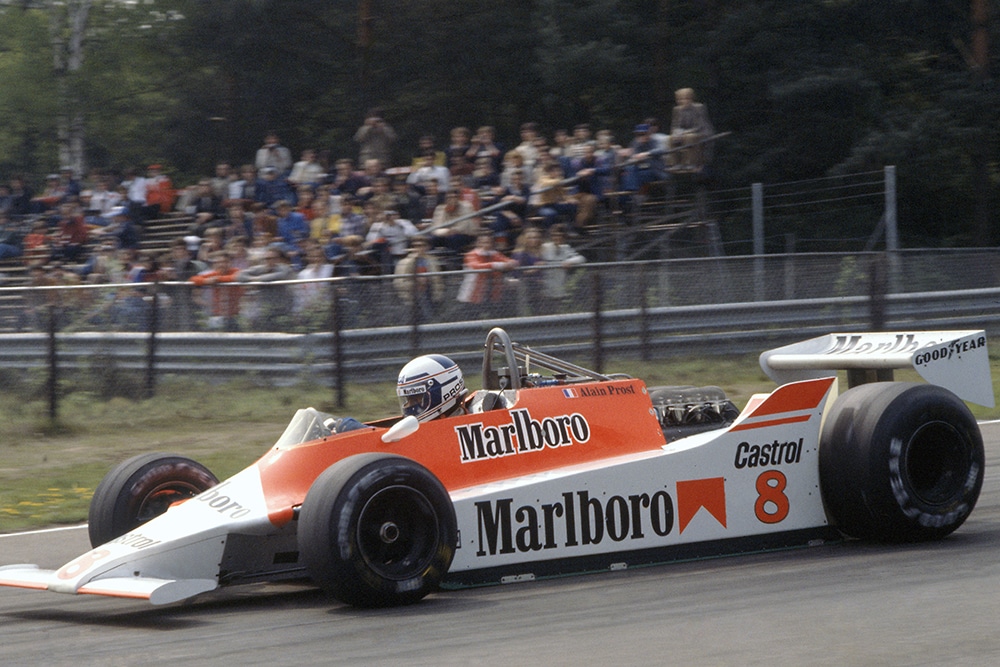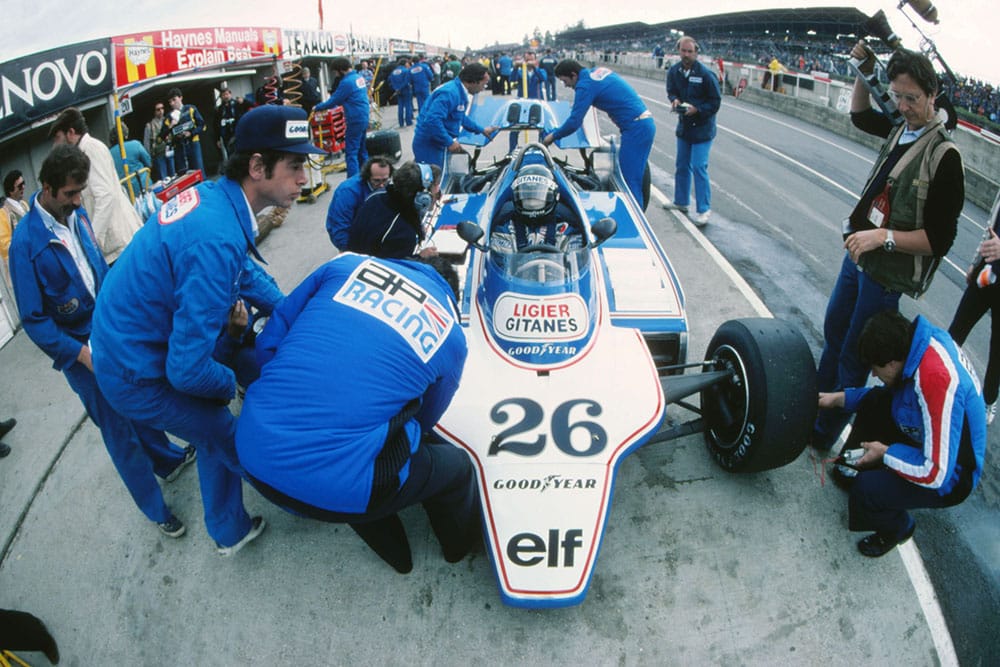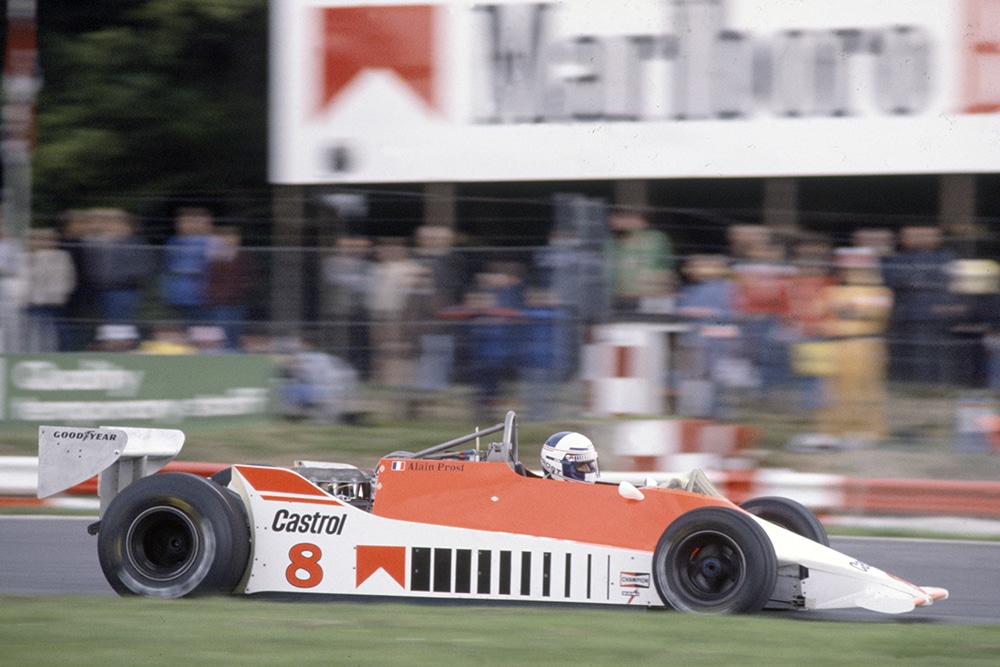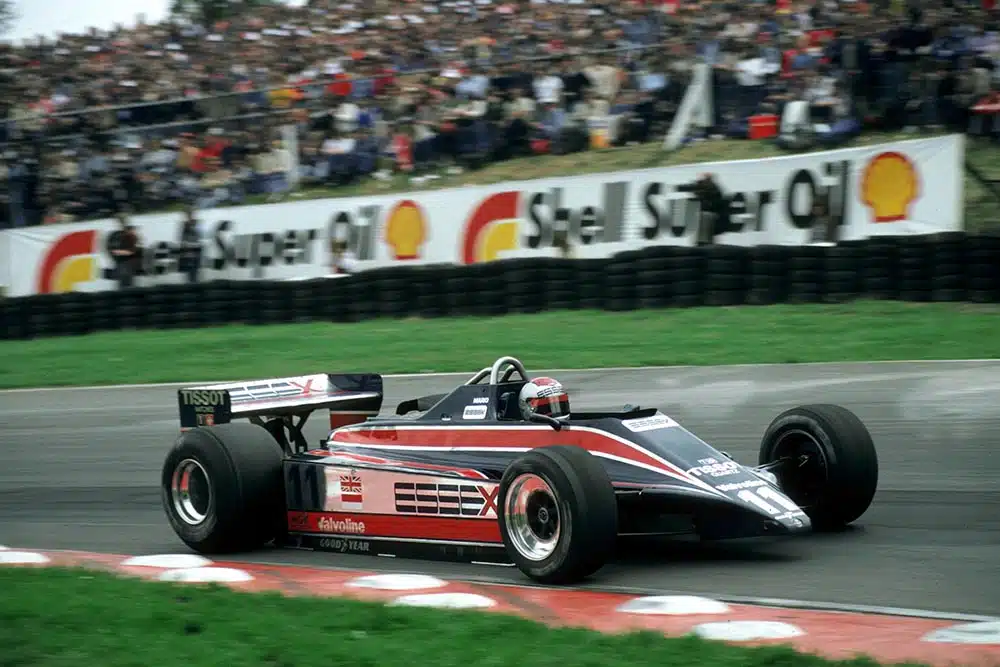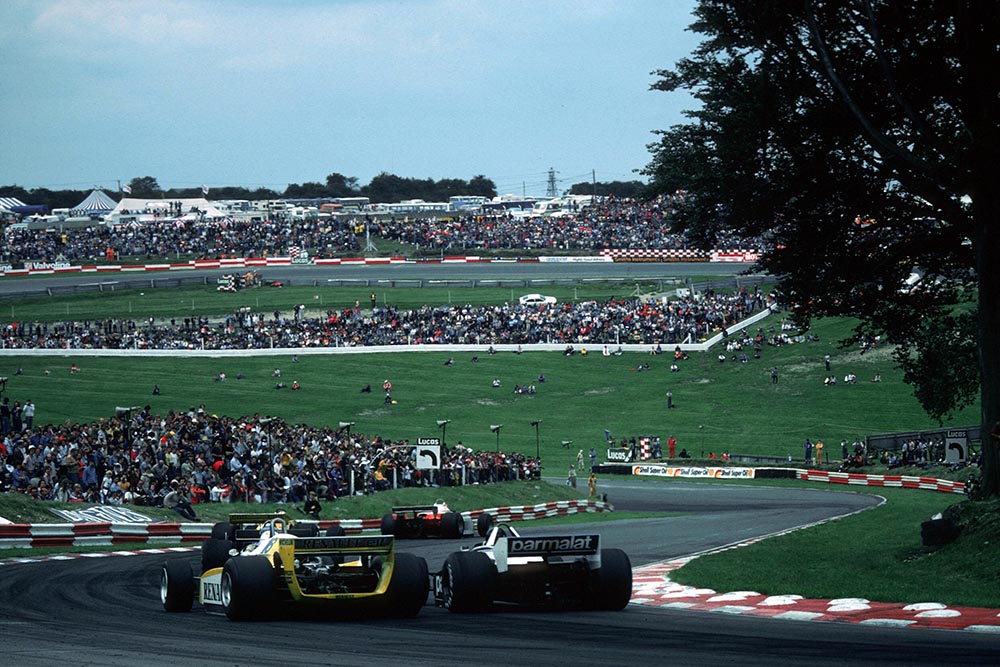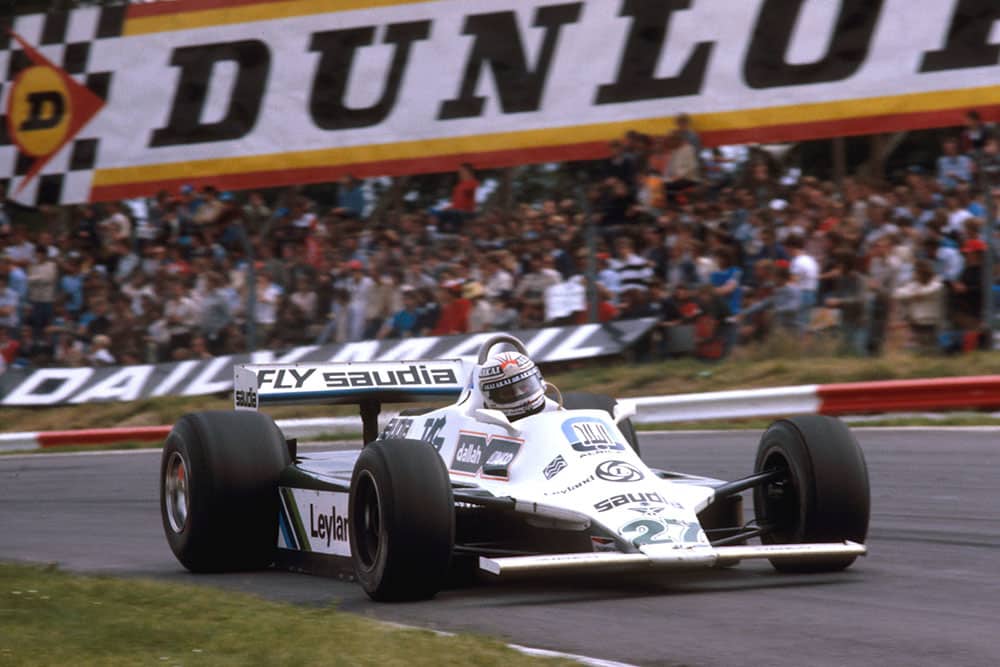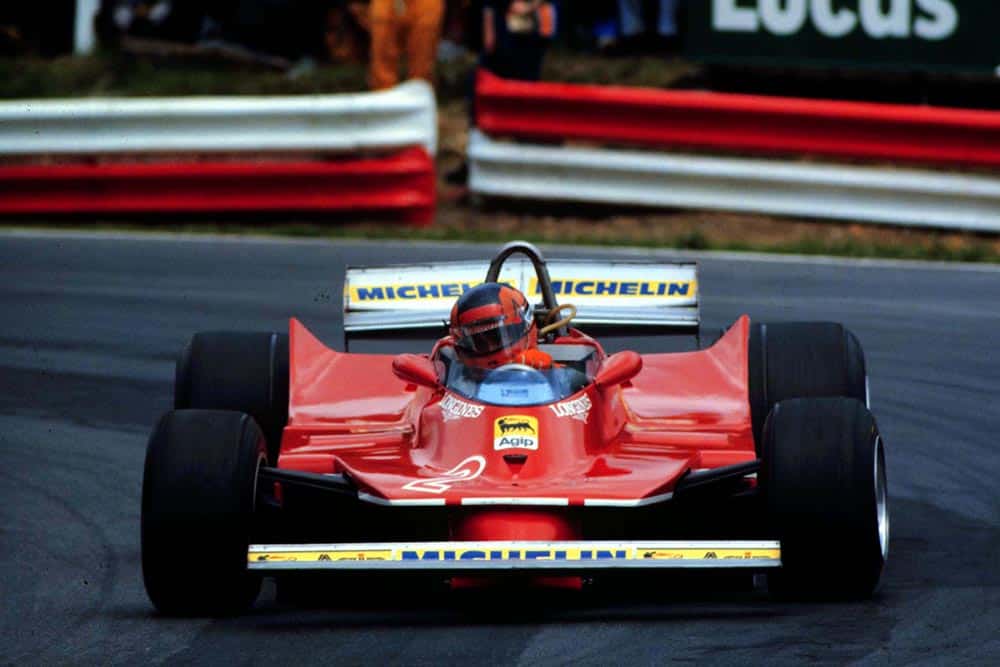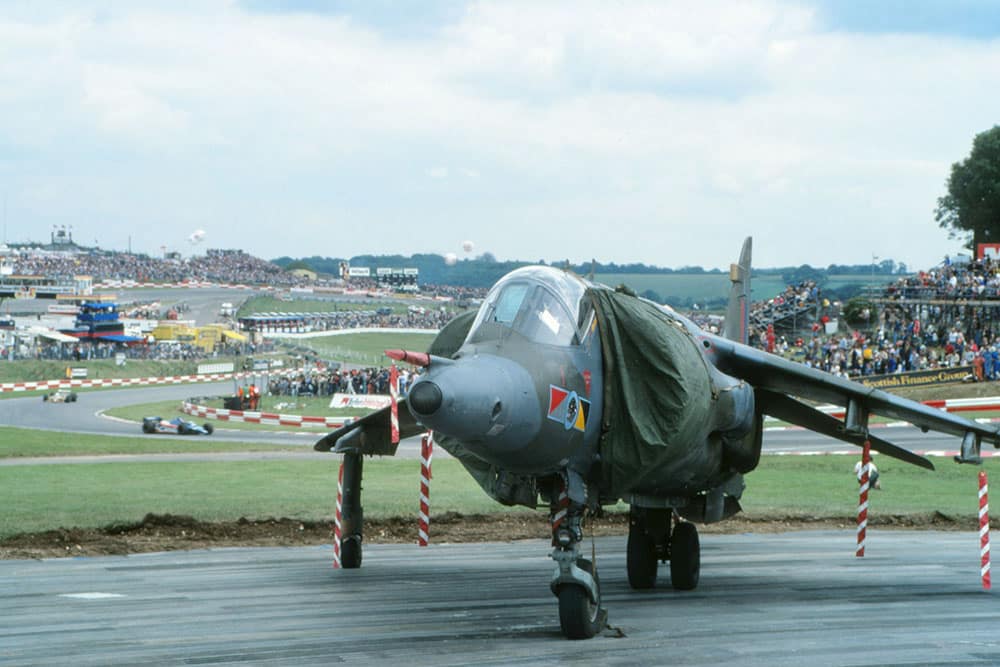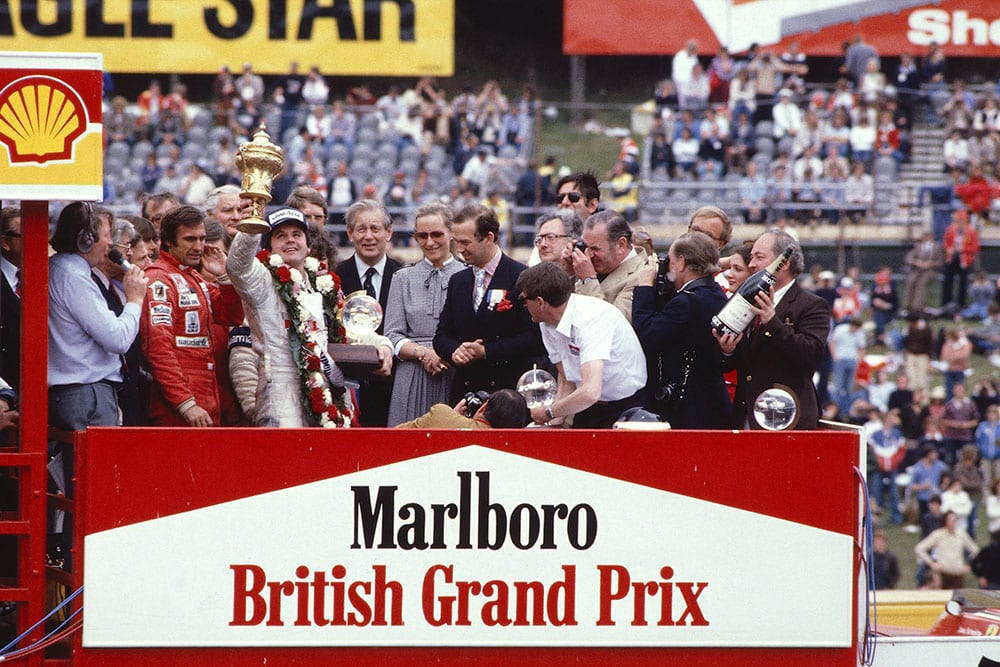1980 British Grand Prix race report - It fell flat
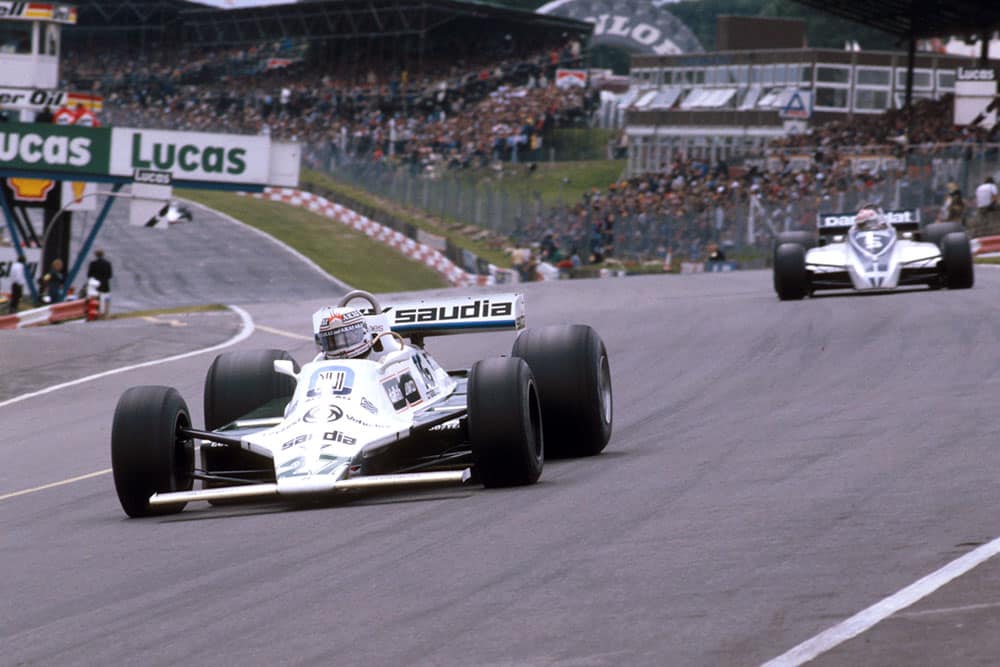
Alan Jones (Williams FW07B Ford) at Paddock Hill Bend, with Nelson Piquet (Brabham BT49 Ford) behind.
© Motorsport Images
It fell flat
Brands Hatch, July 13th
Enthusiasm was running high for the British Grand Prix two or three weeks before the event was due to be held at the Brands Hatch circuit in Kent. Renault had visited the circuit with Michelin and Rene Arnoux had knocked some three seconds off the existing lap record, and then on a Goodyear test day Didier Pironi (Ligier) and Alan Jones (Williams) had improved on the Renault time by another incredible two seconds, averaging 130 mph round the tight little circuit. The cornering speeds being achieved by the best of this year’s Formula One cars are breath-taking, and the Ligier and the Williams through Clearways Bend and Paddock Hill Bend were worth going a long way to see. Some observers, or rather people in the paddock who talk rather than watch, seemed concerned about these incredible cornering speeds. I would have thought that the only people who need be concerned are the drivers, but I can’t say I detected any concern from Pironi or Jones. To watch these two drivers from the outside of Clearways was as exciting as the old Woodcote Corner at Silverstone. (Do you remember Ronnie Peterson in the Lotus 72 before the corner was emasculated by that silly chicane?). To listen to some people you wonder why we are bothering to race, we all ought to play tennis or croquet (or even ping-pong). However, to get down to the real business of the British Grand Prix.
- Didier Pironi leads team mate Jacques Lafitte (Both Ligier JS11/15 Ford’s), Alan Jones, Carlos Reutemann (Both Williams FW07B’s), Nelson Piquet (Brabham BT49 Ford) and Bruno Giacomelli (Alfa Romeo 179) at the start.
The British summer was at its height, with grey clouds, cold winds and rain when the Brands Hatch Stadium was invaded by the contractors men to set up our biggest circus and fun-fair, and even some of the regular grass car parks disappeared under a sea of marquees and motor homes as the migrant world of Formula One entrenched themselves for their three-day sojourn in the lee of the new Motorway in the Garden of England. In these changing times there were some changes to be seen in the pit lane, some of them explicable, others not. The sad Shadow team have gone from the scene, to join March, BRM, Surtees, Wolf, Tecno, de Tomaso and all the others who have helped to create Formula One history. The two drivers, Geoff Lees and David Kennedy are out of work, but many of the mechanics got themselves jobs with other teams. In the Brabham team Ricardo Zunino had been replaced by Hector Rebaque, and presumably money and Mr. Ecclestone were involved, while the Fittipaldi team were all excited at having a brand new design for their patron. This was the F8, designed from scratch by Harvey Postlethwaite, as distinct from the F7, which was an amalgam of ideas from the old Wolf cars and the old Fittipaldi cars. There were two additions to the regular ranks of the entry in the shape of Mrs Desire Wilson and Rupert Keegan; both were driving 1979 Williams cars operated by RAM Racing under the leadership of John MacDonald with the help of Howden Ganley on the technical side. The two cars were FW07/3 and FW07/2, respectively, and have been up-rated from Aurora Formula One trim to full FISA Formula One conditions with sliding side-skirts and all the other important little details that the Williams factory decided were needed to make the cars competitive. This meant there were twenty-seven drivers competing for twenty-four starting grid positions, so the battle for the last row was going to be as competitive as that for the front row.
- Alain Prost at the wheel of his McLaren M29-Ford Cosworth.
When the initial untimed test-session began on Friday morning it was cool and cloudy, but at least it was dry, and conditions were good for some fast motoring, provided you could get your tyres hot enough, which the Goodyear runners seemed easily able to do, whereas the Michelin-shod cars were not at all happy. The session had hardly begun before the new Fittipaldi car gave trouble, after having performed well in pre-race testing, so most of the morning was spent putting it right. The Ligiers were in their Paul Ricard configuration as regards the bodywork and the aerodynamic aids and it was not long before it was obvious that Pironi was going to be the man to beat, and that Alan Jones was the man most likely to. The Arrows cars had new nosepieces with small skirts attached to them to form an air channel down the centre of the car, but they were soon removed as they apparently didn’t work. Both Ensigns for Lammers were in short-wheelbase form, and Depailler was driving the latest Alfa Romeo with the lower-mounted engine. Brabhams were trying out their Weismann transverse gearbox on their spare car, and Williams had a new spare car for Jones fitted with an improved gear linkage. Villeneuve was in a brand new T5 Ferrari, but not for long as it went wrong in the engine department and he transferred to the spare car. All down the field the driving was a bit wild and woolly with slides over kerbs, which damaged skirts, and spins which damaged images, while Pironi had a big excursion onto the grass when a tyre punctured.
Weather conditions remained stable for the vital afternoon session between 1 pm and 2 pm when lap times were taken officially, and counted for grid positions. With a very unsettled weather forecast everyone was out to “give it all they’d got” instantly, just in case the weather changed. The new Fittipaldi was working again, Depailler was quite happy with the “low-engine” Alfa Romeo, the Brabham team had cured a spot of trouble they’d had with the Weismann gearbox and Ligier had reset their suspension to use the 15″ diameter Goodyear front tyres, mounted on Gotti wheels instead of the usual Dymag wheels. Williams were assembling some new 15″ diameter Speedline front wheels for their cars, but Renault and Ferrari were very unhappy, as were Michelin, because they could not record sufficient temperature in their tyres to create the maximum grip. Ferrari had additional trouble for Scheckter’s engine broke and before he could use the spare car the seat and pedals and steering wheel had to be altered from the settings of the morning when Villeneuve had used it. Piquet had a slight accident at Druids Hairpin, when he spun, and, bent the right hand steering arm and suspension, but took a short cut into the pits through the backdoor and took over the spare car with the Weismann gearbox. The pace was pretty fast all down the field, and fast and slow (relatively) drivers were having spins or excursions onto the grass.
- Jacques Laffite in a Ligier JS11/15 in the pits.
It was still Pironi who was the man to beat, he and Jones being outstanding on Clearways Bend ( or Clark Curve in the modern Brands Hatch idiom). The existing lap record was held by Nelson Piquet in a Brabham-Alfa Romeo in 1 min 17.46 sec, set up in the Race of Champions in 1979, while the fastest lap ever made at Brands Hatch was 1 min 16.80 sec, which Ronnie Peterson recorded in 1978 to claim pole-position on the grid for the Grand Prix that year. Two years later and the pole-position time of 1978 was not even considered as good average, while the existing lap record was no criterion at all. Even the times recorded in the Goodyear tyre test session were no longer looking so impressive. It was still a clear-cut battle between Ligier and Williams, both drivers of both teams being in a group of their own, with times in the 1 min 11 sec bracket, with Pironi fastest of all in 1 min 11.004 sec. Even the tail-enders were trying hard and were around the existing lap record, but it was not good enough to qualify for the grid, such is the progress in Formula One when everyone is trying hard. The McLaren team’s fortunes were beginning to look up, with Prost in fifth place at the end of the day, the M29C having improved rear suspension with a more rigid layout, but the performance was put into perspective when you realised that Prost’s time of 1 min 12.759 sec was one and three-quarter seconds off the time of Pironi. The new Fittipaldi was plagued by fuel system troubles and never completed a decent lap.
Saturday morning’s test-session was held under dark and ominous skies, but the rain held off, though it was little consolation to Ferrari and Renault for their Michelin tyres just were not equal to the Goodyears in the cold climate. The Ferraris were looking terrible round the fast comers, wobbling about and looking totally unbalanced, whereas the Ligiers and Williams were looking beautifully stable, in spite of being much faster through the corners. At least the Ferraris sounded nice. During Friday’s practice some of the tougher elements among the “foreign” drivers were getting a bit rough with Desire Wilson when they came up to pass her, feeling that a woman’s place is in the home (or in Club racing) not in World Championship class Formula One. On Saturday morning the Ligier drivers were feeling the same about the Irish! Derek Daly was going well by Tyrrell standards, but he was in the way as far as Laffite and Pironi were concerned, and he ignored (or didn’t see) the blue flags and just would not let them by. Laffite became very excited and frustrated, while the cold, ruthless Pironi stood it for a short time and then knocked the Tyrrell off onto the grass and out of the way! It is very tough at the top these days, which is why we get some good racing when the rubbish gets out of the way.
- Alain Prost in a McLaren M29C-Ford Cosworth.
In mid-field Marc Surer was pedalling the newer ATS round very effectively, at least as well, if not better than Jan Lammers had done, whereas Lammers was getting nowhere with the red, white and blue Ensign. At one point the ATS caught and passed the Ensign as if it was standing still, which must have been very frustrating for the little Dutch driver. Had he been in the second ATS he could have been going as quickly. For up-and-coming drivers these sort of things are bad, but they are far worse for top drivers, and Scheckter and Villeneuve were suffering the indignity of being passed by drivers with far less talent. Scheckter spun off into the barriers in his own car after Stirling’s Bend and ran back to the pits to climb once more into the spare car. The new Fittipaldi was behaving itself now, its suspension and fuel feed problems overcome, but Rosberg was looking like a non-qualifier, which he will continue to do until he relaxes a bit and gets some smoothness into his driving. Many years ago Alan Jones’ father told him “Learn to drive smoothly first of all, speed will then come naturally”. It would appear that Stan Jones was right. Scheckter’s morning ended at rock bottom when the spare Ferrari developed engine trouble, and he was next to last, only Depailler being slower because his engine would not run cleanly. The final “all or nothing” hour was from 1.30 pm to 2.30 pm and the weather was still grey but dry. In despair Michelin were cutting circumferential grooves in the tyres for Renault and Ferrari to try and make the rubber “work” a bit and raise the temperature, but it seemed a forlorn hope. The Ferrari mechanics were still slaving away when the timed session began, finishing off the two race-cars for Scheckter and Villeneuve. In the Ligier and Williams pits all was under control and Jones began practice in the new T-car, while Pironi and Laffite were brimful of confidence. Patrick Depailler was being forced to use the spare Alfa Romeo as the engine in his own car would not respond to attention, and Surer was in the earlier of the two ATS cars. All was going well and the pace was really hotting up when, Arnoux lost control of his Renault leaving the’ Druids hairpin and crashed heavily at the foot of the hill. The red flag came out at the start/finish line and qualifying stopped while the Frenchman was released from the bent car, fortunately with only superficial damage to a hand and some nasty bruises. The wrecked Renault RE24 was removed on a breakdown lorry and the spare Renault’s cockpit was re-arranged to fit the tough little Frenchman who was all set to carry on.
- Mario Andretti in a Lotus 81.
When qualifying re-started after 20 minutes the pace got really fierce, but it was still the two Ligier drivers and the two Williams drivers who were setting the pace, all in the 1 min. 11 sec bracket, but Nelson Piquet was hot on their heels with his Brabham BT49/8. He joined this select group with 1 min 11.634 sec and he was really trying, eventually trying too hard and having a monumental spin as he left Clearways Corner, which took him right along the grass verge as far as the pits, but no damage was done. Not long after this de Angelis lost control over the hump on the same comer and spun into the barriers with a sickening thud which bent the Lotus 81/3 quite badly. He left it there and walked to the pits. In the Alfa Romeo camp Giacomelli was going well but Depailler was having a terrible time as the engine in the spare car was refusing to run decently. As a last gasp Giacomelli was called in and the Frenchman went off in 179/02 to make his best time of the afternoon, but not as good as his Friday time. Scheckter was back in the spare Ferrari, but little good it did him, and right at the end of the delayed hour Keegan got in a muddle passing Mrs Wilson and crashed heavily into the barriers at Westfield Corner, damaging FW07/2 pretty extensively, but escaping unhurt, and just to round off the day Villeneuve spun his Ferrari so quickly that he gathered it up and was gone before the marshal could wave the yellow flag, and the Brands Hatch marshals are amongst the quickest!
When the dust had settled a remarkable starting grid was sorted out from the two days of testing and timing. On pole position with a time of 1 min 11.004 sec was the ruffled, but determined Didier Pironi in the blue and white Ligier. In second place, but nearly half-a-second down, was Jacques Laffite in the second Ligier, and then came Jones and Reutemann in the Williams cars and Piquet in his Brabham, so close to each other that second places of decimals, or hundredths of a second separated them, all five drivers in the select 1 min 11 sec bracket and all of them more than five-and-a-half seconds faster than the existing lap record, and a little over five seconds faster than the previous best lap ever recorded at Brands Hatch. While some people were throwing their hands up in dismay and apprehension. I found it all very exciting. The Alfa Romeos were looking pretty good, and Prost had raised McLaren’s hopes, while the Tyrrell drivers actually brought a smile to the wood-merchant’s hatchet features with their tenth and eleventh places. The Renault team were no higher than they expected to be on the twisty and tight little Kentish circuit, but the Ferrari team were in despair, with World Champion Scheckter next to last and Villeneuve not very far ahead. Lotus were a little happier, with Andretti in ninth place, from where he could at least see the front of the grid, unlike the Arrows team who were right down the back. Hector Rebaque had got quietly on with the job, and qualified comfortably, as had Keegan, but Mrs Wilson was very depressed at being last, finding that real Formula One racing is a bit different from Aurora racing which is called Formula One. Unipart had another great social “gastronomic orgy” for their customers and clients with only a non-starter to celebrate and Fittipaldi just scraped in near the back of the grid with his new car. When you realise that Desire Wilson was the slowest of the entire entry, and her best time of 1 min. 16.315 sec was faster than Ronnie Peterson’s pole-position winning time of 1978 and faster than Nelson Piquet’s existing lap record set up in 1979, it makes you hold your head and say “whew!”
- Rene Arnoux in a Renault RE24 battles with Hector Rebaque in his Brabham BT49.
Although rain was forecast for Sunday it was hoped that it would hold off until the late afternoon, but just in case, one or two teams brushed up on their wheel-changing drill at the end of the morning warm-up period. The only unfortunate occurrence was that Cheever stopped with engine trouble on the Osella and his team had hurriedly to prepare their second car. For the rest all was as near in order as it was ever going to be. Arnoux was in the T-Renault, de Angelis was in the T-Lotus and Keegan had taken over Mrs Wilson’s car. There had been a lot of work going on through Saturday evening. Alan Jones had decided to race his regular car, number 7, though the new one was all warmed-up and ready to go should he change his mind. During the interval between the end of the warm-up period and the preliminaries for the race most people had lunch, but the mechanics were all busy with final preparations, filling the fuel tanks, checking everything, mounting the correct wheels and tyres, preparing the spare ones, arranging tools and equipment for any emergency and all the hundred and one other things necessary before a race. Meanwhile the drivers all dutifully went to the official “driver briefing” as called for in FISA regulations, which was held in a coach at the end of the pits. They were then expected to climb into the passenger seats of a parade of MG cars for a lap of the circuit, and then find time for a sandwich and a glass of milk and prepare themselves for the 3 pm start, so it was not surprising that many of them opted out of the parade. The whole time-schedule was much too tight.
In good time all 24 cars left. the pit lane and were driven round to the grid and then Pironi led them away on a pretty fast line-astern parade lap to the start. The red light came on, revs rose, clutches bit and then the green light shone and the field surged towards Paddock Bend with Pironi in the lead with Laffite on his left. Pironi’s start was superb but Jones was not as good and as he tried to take the inside line Laffite moved over on him and they sat it out in good clean competition with the Williams right on the inside edge, until the Australian had to give in and the second Ligier followed the first down the hill and up to Druids Hairpin. Pironi powered away, confident that Laffite would be doing his best to make things difficult for the opposition. By the end of the opening lap Pironi had already pulled out a measurable lead, and it was quite obvious that Jones could do no more than hold on to Laffite, while Nelson Piquet was right with them. Reutemann was leading the rest and Fittipaldi was bringing up the rear. By the end of practice and qualifying it seemed that we were in for an exciting battle between the two Ligiers and the two Williams, with a Brabham in amongst them for good measure, but it needed only a handful of laps to show that this was not going to happen. Pironi was running away into the distance, Jones and Piquet could only just stay with Laffite and Reutemann was in a different race. For an exciting moment it looked as though Watson was overtaking Jabouille’s Renault, but then the French car coasted to a stop with a seized engine. Laffite was pulling away from Jones and Piquet and by 10 laps it was all over, or seemed to be, with the two blue and white French cars with their French drivers out-speeding everyone and looking fast, safe and steady. In third place came the Williams of Alan Jones, with Piquet’s Brabham in his wake, then came Reutemann on his own, followed by the two Alfa Romeos in the order Depailler, Giacomelli. In eighth place came Daly (Tyrrell) on his own and team-mate Jarier was in tenth place, just behind Andretti’s Lotus. The two McLaren’s were next and then there was a long gap before Villeneuve’s Ferrari and the second Lotus appeared. Keegan, Surer and Rebaque were having a nice dice of little consequence and Arnoux was doing the best he could under the handicap of bruised ribs. Bringing up the rear were Patrese, Scheckter, Mass and Fitipaldi as Cheever went into the pits to try different front tyres. Elio de Angelis was unhappy with the feel of the spare Lotus and stopped at the pits as did Prost when he found he could not pass Watson, and he changed front tyres. Then when Giacomelli realised Daly was closing on him, he too stopped to change tyres.
- Alan Jones (Williams FW07B Ford) 1st position at Druids.
On lap 17 it looked as though Pironi was in trouble, for Laffite was closing on him and on lap 18 he was quite close. On lap 19 Laffite went by into the lead as Pironi slowed drastically with a soft front tyre and by the time he reached the pit lane Jones, Piquet and Reutemann had gone by. There was some confusion in the Ligier pit and they subsequently changed all four tyres, but not in one smooth operation, so that by the time Pironi rejoined the race he was down in last place, two laps behind his leading team-mate. From a dominant 1-2 the Ligier team had gone to 1-21; but it immediately became 1-20 as Villeneuve pulled into the pits with a sticking side-skirt and ignition trouble on his Ferrari. While all this was going on Cheever veered off onto the centre grass patch of Clearways as the right-rear suspension rocker-arm broke and the rear wheels took charge of the directional stability. Everything was falling apart now, for Depailler dropped out of the running to change front tyres, Villeneuve was back in again, and Mass broke his steering wheel. Depailler’s Alfa Romeo broke its engine and Laffite was well on to lapping the mid-field runners. As he lapped Surer, who was in ninth place, he ran wide at Clearways and got on the loose stuff with his left wheels, and shook his fist at the young Swiss as he came back on to the track. This was at the end of lap 27. Two laps later his left tyre was showing signs of deflating and he was getting into some wild slides on right-hand bends. By the time he was on lap 31 he knew he had trouble, but it was too late and the tyre split circumferentially near its outer edge and the Ligier slid off into the run-off area at Hawthorn Corner and was out of the race. A smiling Alan Jones inherited the lead and from a position of total dominance the Ligier team had disappeared, except that Pironi had other ideas and was already up to twelfth place and going faster than anyone on the track. He had caught and passed Depailler, before he retired, Mass before his pit-stop, Fittipaldi, Arnoux, Patrese, Scheckter and Keegan and was now after Prost. When Scheckter was lapped by Daly, who was running in a good fourth place by now, he went into the pits to change tyres. Arnoux was in the pits for a long time while a plug on a rear caliper which was leaking fluid was replaced.
By half distance, which was 38 laps any hope of excitement had gone and it was just a case of watching Jones do a good master-driver’s job of work in a car that was going superbly; a real credit to the Williams team preparation. Piguet was a distant second and Reutemann a distant third. Daly, Andretti and Jarier followed, in that order, all on the same lap as Jones, but not for long, and already lapped were Watson, Giacomelli, Surer and Rebaque while Pironi was charging up through the field as was Prost, albeit at a slightly diminished rate to that of the Ligier driver. Tailing along still were Patrese, Fittipaldi, Scheckter, Keegan, Mass and Arnoux, and then Villeneuve disappeared from the end of the field when his Ferrari engine broke.
- Gilles VIlleneuve competes at Brands Hatch.
Apart from admiring Jones’ smooth driving and the stability of the Williams the only interest lay in Pironi’s progress. He had no hope of regaining the lead but he could still pick up plenty of places and between lap 38 and lap 48 he caught and passed Surer, Rebaque, Giacomelli and Watson, which put him into seventh place, but he hadn’t finished. While Andretti was fumbling with a recalcitrant gearchange Jarier passed the Lotus, then Pironi passed it and then Andretti retired at the pits. Jarier was easy meat for Pironi, which moved him up to fifth place and then he came up behind Daly, no doubt remembering what happened in practice. This time Daly was more than justified in not giving way, as fourth place was at stake and he knew it. Knowing he was being hounded by Pironi he can be excused for getting in the way when Alan Jones lapped him but by lap 62 Pironi had the Tyrrell in his sights. Before he could deal with it the left rear tyre on the Ligier failed and Pironi swerved onto the grass on the inside of Westfields Corner, at the far side of circuit, and his race was run as he came to rest with the tyre a tangled mess around the rim. While some drivers will charge up from last place with passion and excitement, driving right on the ragged edge of disaster and playing it right up to the line, as for example Arnoux and Villeneuve have done in the past, Pironi’s progress was cold, hard, ruthless, unemotional and a bit “spooky”. He left the lap record at 1 min 12.368 sec (125.690 mph) having done more than a dozen laps consecutively in the 1 min 12 sec bracket, while everyone else was in the 1 min 13 sec bracket, and yet no sense of achievement was apparent. In the past people said Niki Lauda was a “machine” not a human being; they should look at Didier Pironi, a driver of the “computer age”! As the television cameras watched him climb out of the cockpit and remove his helmet and balaclava there was no sign of emotion, satisfaction, frustration, anger or disappointment – it was just Didier Pironi, driver of the Ligier racing car.
- The RAF Harrier of Flt. Lt. Dudley Carvell parked on the inside of Clearways corner after wowing the crowd during a pre-race display.
It was now really all over, Prost had caught and passed his team-mate, who then went into the pits to change tyres, Surer’s spirited drive came to an end when his engine blew up in mid-corner and he spun off onto the grass at South Bank and the burly Alan Jones won another very satisfying race for the Frank Williams team and their Saudi Arabian sponsors and for Leyland Vehicles. The ubiquitous Ford-sponsored Cosworth DFV engine had done it again, as had Mike Hewland’s gearbox, Goodyear tyres, and Ferodo, Lockheed, Koni, Champion, Speedline, Mobil, and all the other branches of engineering that Patrick Head co-ordinates so successfully around his FW07 design, not forgetting all the fabricators, fitters, machinist, welders, riveters and mechanics who build and prepare the cars. It was all those and more beside he was referring to when Jones said after the race “I’d like to thank everyone in the Williams team for making this day possible for me”.
Nelson Piguet followed him home, slowing towards the end as his tyres wore down and Reutemann was third, everyone else being a lap or more behind. Thankful for small mercies the Tyrrell team netted fourth and fifth, which was a change from gathering up wrecked cars afterwards, and Prost was sixth with a drive after his pit stop that showed his true potential. Rebaque did well to finish non-stop in seventh place in liis first drive in a “works” car. The courageous Arnoux was last and too far back to be officially classified as a finisher.
- Alan Jones (Williams Ford) celebrates his 1st position on the podium. TRH Prince and Princess Michael of Kent stand to the right and Carlos Reutemann (Williams Ford) 3rd position and commentator Brian Jones to the left.
Practice had flattered to deceive. What had augered to be a fantastic battle between the Ligiers and Williams had fallen flat, but nevertheless it was a popular victory and the huge crowd gave Alan Jones the reception he deserved; not only for winning the British Grand Prix but for all the other races he has won which few of the British spectators have been fortunate enough to witness. Now they had seen him in action they really showed their appreciation. – DSJ.
